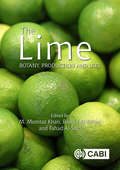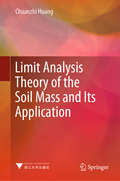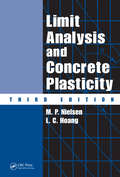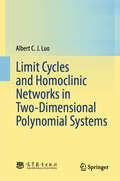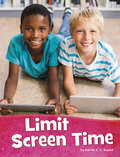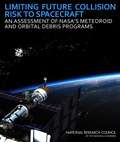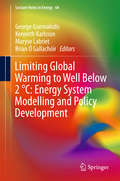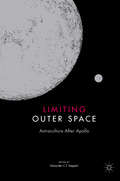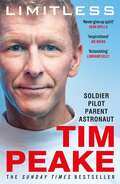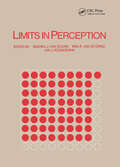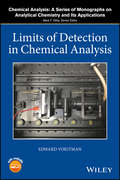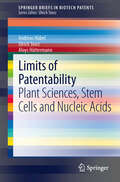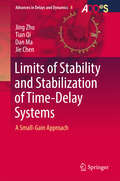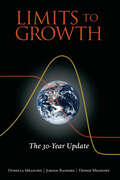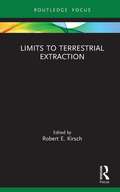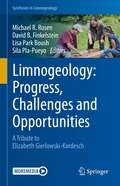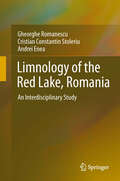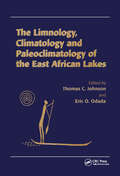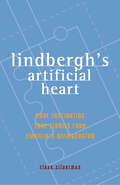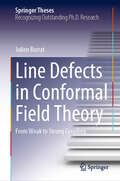- Table View
- List View
Lime, The: Botany, Production and Uses (Botany, Production and Uses)
by W Ahmed M A Ali G Almaguer-Vargas A M Al-Saidi A Al-Maskary U Ammara C F Aquino N Cruz-Huerta D L Siqueira P Donkersley S L Elliot A A Farooque F García-Sánchez V Gimeno V González-Hernández M A Hanif R Janke M L Keremane A S Khan Y Z Liu B S Marquez J J Martínez-Nicolás A Nasehi M A Nawaz S Padmanabhan R B Queiroz C Ramadugu I Ramírez-Ramírez M F Razi M L Roose L C Salomão A W Schumann R W Scora S Simón-Grao Z Singh A K Srivastava M Usman M Waly Q U ZamanThe lime is an important fruit crop throughout the citrus producing regions of the world, with its own specific benefits and issues affecting successful cultivation and production. Limes: Botany, Production and Uses covers the breeding, genetics and biodiversity of the plants, and explains the processes for establishing a lime orchard, including propagation techniques, pruning and thinning of established trees, water requirements and irrigation systems. All the major problems of lime cultivation are explored and discussed, including increasing threats such as Witches' Broom Disease and Citrus Greening, along with approaches for pest and disease management and prevention.
Limit Analysis Theory of the Soil Mass and Its Application
by Chuanzhi HuangThis book establishes the equations of limit analysis and provides a complete theoretical basis for foundation capacity, slope stability, and earth pressure. It is divided into three parts, the first of which discusses the failure mode and fundamental equation of soil mass. The second part addresses the solution methods for limit analysis, including the characteristic line method, stress field method, limit equilibrium method, virtual work equation-based generalized limit equilibrium method and generalized limit equilibrium method for the surface failure mode. Lastly, the third part examines the application of the limit analysis theory to soil mass.
Limit Analysis and Concrete Plasticity
by M.P. Nielsen L.C. HoangLimit Analysis and Concrete Plasticity, Second Edition explains the basic principles of plasticity theory and its application to the design of reinforced and prestressed concrete structures, providing a thorough understanding of the subject, rather than simply applying current design codes. This understanding enables the design student or engineer to solve problems more effectively and safely. Fully updated, the second edition includes new treatments in a variety of areas and includes numerical methods and computer code for solving problems, incorporating methods into Eurocode 2-the common concrete standard for all of Europe.
Limit Cycles and Homoclinic Networks in Two-Dimensional Polynomial Systems
by Albert C. LuoThis book is a monograph about limit cycles and homoclinic networks in polynomial systems. The study of dynamical behaviors of polynomial dynamical systems was stimulated by Hilbert’s sixteenth problem in 1900. Many scientists have tried to work on Hilbert's sixteenth problem, but no significant results have been achieved yet. In this book, the properties of equilibriums in planar polynomial dynamical systems are studied. The corresponding first integral manifolds are determined. The homoclinic networks of saddles and centers (or limit cycles) in crossing-univariate polynomial systems are discussed, and the corresponding bifurcation theory is developed. The corresponding first integral manifolds are polynomial functions. The maximum numbers of centers and saddles in homoclinic networks are obtained, and the maximum numbers of sinks, sources, and saddles in homoclinic networks without centers are obtained as well. Such studies are to achieve global dynamics of planar polynomial dynamical systems, which can help one study global behaviors in nonlinear dynamical systems in physics, chemical reaction dynamics, engineering dynamics, and so on. This book is a reference for graduate students and researchers in the field of dynamical systems and control in mathematics, mechanical, and electrical engineering.
Limit Screen Time (Health and My Body)
by Martha E. RustadWe watch videos on our smartphones and tablets. We read books on E-readers. Devices with screens are part of our everyday lives. But too much time on these devices can be unhealthy. Engaging text and colorful photos explain how to cut the screen time. Limit Screen Time includes a glossary, read more section, kid-friendly internet sites, and an index.
Limited Boxed Set: Bill Gates, Big Pharma, and the Global War on Democracy and Public Health (Children’s Health Defense)
by Robert F. Kennedy Jr.#1 on AMAZON, and a NEW YORK TIMES, WALL STREET JOURNAL, USA TODAY and PUBLISHERS WEEKLY NATIONAL BESTSELLERPharma-funded mainstream media has convinced millions of Americans that Dr. Anthony Fauci is a hero. He is anything but.As director of the National Institute of Allergy and Infectious Diseases (NIAID), Dr. Anthony Fauci dispenses $6.1 billion in annual taxpayer-provided funding for scientific research, allowing him to dictate the subject, content, and outcome of scientific health research across the globe. Fauci uses the financial clout at his disposal to wield extraordinary influence over hospitals, universities, journals, and thousands of influential doctors and scientists—whose careers and institutions he has the power to ruin, advance, or reward. During more than a year of painstaking and meticulous research, Robert F. Kennedy Jr. unearthed a shocking story that obliterates media spin on Dr. Fauci . . . and that will alarm every American—Democrat or Republican—who cares about democracy, our Constitution, and the future of our children&’s health. The Real Anthony Fauci reveals how &“America&’s Doctor&” launched his career during the early AIDS crisis by partnering with pharmaceutical companies to sabotage safe and effective off-patent therapeutic treatments for AIDS. Fauci orchestrated fraudulent studies, and then pressured US Food and Drug Administration (FDA) regulators into approving a deadly chemotherapy treatment he had good reason to know was worthless against AIDS. Fauci repeatedly violated federal laws to allow his Pharma partners to use impoverished and dark-skinned children as lab rats in deadly experiments with toxic AIDS and cancer chemotherapies. In early 2000, Fauci shook hands with Bill Gates in the library of Gates&’ $147 million Seattle mansion, cementing a partnership that would aim to control an increasingly profitable $60 billion global vaccine enterprise with unlimited growth potential. Through funding leverage and carefully cultivated personal relationships with heads of state and leading media and social media institutions, the Pharma-Fauci-Gates alliance exercises dominion over global health policy. The Real Anthony Fauci details how Fauci, Gates, and their cohorts use their control of media outlets, scientific journals, key government and quasi-governmental agencies, global intelligence agencies, and influential scientists and physicians to flood the public with fearful propaganda about COVID-19 virulence and pathogenesis, and to muzzle debate and ruthlessly censor dissent.
Limiting Future Collision Risk to Spacecraft
by The National Academy of SciencesDerelict satellites, equipment and other debris orbiting Earth (aka space junk) have been accumulating for many decades and could damage or even possibly destroy satellites and human spacecraft if they collide. During the past 50 years, various National Aeronautics and Space Administration (NASA) communities have contributed significantly to maturing meteoroid and orbital debris (MMOD) programs to their current state. Satellites have been redesigned to protect critical components from MMOD damage by moving critical components from exterior surfaces to deep inside a satellite's structure. Orbits are monitored and altered to minimize the risk of collision with tracked orbital debris. MMOD shielding added to the International Space Station (ISS) protects critical components and astronauts from potentially catastrophic damage that might result from smaller, untracked debris and meteoroid impacts. Limiting Future Collision Risk to Spacecraft: An Assessment of NASA's Meteoroid and Orbital Debris Programexamines NASA's efforts to understand the meteoroid and orbital debris environment, identifies what NASA is and is not doing to mitigate the risks posed by this threat, and makes recommendations as to how they can improve their programs. While the report identified many positive aspects of NASA's MMOD programs and efforts including responsible use of resources, it recommends that the agency develop a formal strategic plan that provides the basis for prioritizing the allocation of funds and effort over various MMOD program needs. Other necessary steps include improvements in long-term modeling, better measurements, more regular updates of the debris environmental models, and other actions to better characterize the long-term evolution of the debris environment.
Limiting Future Collision Risk to Spacecraft: An Assessment of NASA's Meteoroid and Orbital Debris Programs
by Aeronautics Space Engineering BoardDerelict satellites, equipment and other debris orbiting Earth (aka space junk) have been accumulating for many decades and could damage or even possibly destroy satellites and human spacecraft if they collide. During the past 50 years, various National Aeronautics and Space Administration (NASA) communities have contributed significantly to maturing meteoroid and orbital debris (MMOD) programs to their current state. Satellites have been redesigned to protect critical components from MMOD damage by moving critical components from exterior surfaces to deep inside a satellite's structure. Orbits are monitored and altered to minimize the risk of collision with tracked orbital debris. MMOD shielding added to the International Space Station (ISS) protects critical components and astronauts from potentially catastrophic damage that might result from smaller, untracked debris and meteoroid impacts. Limiting Future Collision Risk to Spacecraft: An Assessment of NASA's Meteoroid and Orbital Debris Program examines NASA's efforts to understand the meteoroid and orbital debris environment, identifies what NASA is and is not doing to mitigate the risks posed by this threat, and makes recommendations as to how they can improve their programs. While the report identified many positive aspects of NASA's MMOD programs and efforts including responsible use of resources, it recommends that the agency develop a formal strategic plan that provides the basis for prioritizing the allocation of funds and effort over various MMOD program needs. Other necessary steps include improvements in long-term modeling, better measurements, more regular updates of the debris environmental models, and other actions to better characterize the long-term evolution of the debris environment.
Limiting Future Collision Risk to Spacecraft: An Assessment of NASA's Meteoroid and Orbital Debris Programs
by Aeronautics Space Engineering BoardDerelict satellites, equipment and other debris orbiting Earth (aka space junk) have been accumulating for many decades and could damage or even possibly destroy satellites and human spacecraft if they collide. During the past 50 years, various National Aeronautics and Space Administration (NASA) communities have contributed significantly to maturing meteoroid and orbital debris (MMOD) programs to their current state. Satellites have been redesigned to protect critical components from MMOD damage by moving critical components from exterior surfaces to deep inside a satellite's structure. Orbits are monitored and altered to minimize the risk of collision with tracked orbital debris. MMOD shielding added to the International Space Station (ISS) protects critical components and astronauts from potentially catastrophic damage that might result from smaller, untracked debris and meteoroid impacts. Limiting Future Collision Risk to Spacecraft: An Assessment of NASA's Meteoroid and Orbital Debris Program examines NASA's efforts to understand the meteoroid and orbital debris environment, identifies what NASA is and is not doing to mitigate the risks posed by this threat, and makes recommendations as to how they can improve their programs. While the report identified many positive aspects of NASA's MMOD programs and efforts including responsible use of resources, it recommends that the agency develop a formal strategic plan that provides the basis for prioritizing the allocation of funds and effort over various MMOD program needs. Other necessary steps include improvements in long-term modeling, better measurements, more regular updates of the debris environmental models, and other actions to better characterize the long-term evolution of the debris environment.
Limiting Global Warming to Well Below 2 °C: Energy System Modelling and Policy Development (Lecture Notes In Energy #64)
by George Giannakidis Maryse Labriet Kenneth Karlsson B. Ó GallachóirThis book presents the energy system roadmaps necessary to limit global temperature increase to below 2°C, in order to avoid the catastrophic impacts of climate change. It provides a unique perspective on and critical understanding of the feasibility of a well-below-2°C world by exploring energy system pathways, technology innovations, behaviour change and the macro-economic impacts of achieving carbon neutrality by mid-century. The transformative changes in the energy transition are explored using energy systems models and scenario analyses that are applied to various cities, countries and at a global scale to offer scientific evidence to underpin complex policy decisions relating to climate change mitigation and interrelated issues like energy security and the energy–water nexus. It includes several chapters directly related to the Nationally Determined Contributions proposed in the context of the recent Paris Agreement on Climate Change. In summary, the book collates a range of concrete analyses at different scales from around the globe, revisiting the roles of countries, cities and local communities in pathways to significantly reduce greenhouse gas emissions and make a well-below-2°C world a reality. A valuable source of information for energy modellers in both the industry and public sectors, it provides a critical understanding of both the feasibility of roadmaps to achieve a well-below-2°C world, and the diversity and wide applications of energy systems models. Encompassing behaviour changes; technology innovations; macro-economic impacts; and other environmental challenges, such as water, it is also of interest to energy economists and engineers, as well as economic modellers working in the field of climate change mitigation.
Limiting Outer Space: Astroculture After Apollo (Palgrave Studies in the History of Science and Technology)
by Alexander C.T. GeppertLimiting Outer Space propels the historicization of outer space by focusing on the Post-Apollo period. After the moon landings, disillusionment set in. Outer space, no longer considered the inevitable destination of human expansion, lost much of its popular appeal, cultural significance and political urgency. With the rapid waning of the worldwide Apollo frenzy, the optimism of the Space Age gave way to an era of space fatigue and planetized limits. Bringing together the history of European astroculture and American-Soviet spaceflight with scholarship on the 1970s, this cutting-edge volume examines the reconfiguration of space imaginaries from a multiplicity of disciplinary perspectives. Rather than invoking oft-repeated narratives of Cold War rivalry and an escalating Space Race, Limiting Outer Space breaks new ground by exploring a hitherto underrated and understudied decade, the Post-Apollo period.
Limitless: The bestselling story of Britain’s inspirational astronaut
by Tim PeakeThe inspirational autobiography of Britain’s beloved astronaut Tim Peake, the #1 bestselling author of Hello, is this Planet Earth? and Ask an AstronautAs heard on BBC Radio 4 Desert Island Discs__________________'What surprised me was how entirely serene I felt. I was weightless, no forces exerting themselves on my body. To my left was the Space Station. Below me, gradually going into shadow, was the Earth. And over my right shoulder was the universe.'In fascinating and personal detail, and drawing on exclusive diaries and audio recordings from his mission, astronaut Tim Peake takes readers closer than ever before to experience what life in space is really like: the sights, the smells, the fear, the sacrifice, the exhilaration and the deep and abiding wonder of the view.Warm, inspiring and often funny, Tim also charts his surprising road to becoming an astronaut, from a shy and unassuming boy from Chichester who had a passion for flight, to a young British Army officer, Apache helicopter pilot, flight instructor and test pilot who served around the world. Tim's extensive eighteen-year career in the Army included the command of a platoon of soldiers in Northern Ireland during the Troubles, deployment in Bosnia, and operations in Afghanistan.Full of life lessons for readers of all ages, Limitless is the story of how ordinary can become extraordinary.__________________'For someone who has literally been out of this world Tim's an incredibly down to earth guy and I think you'll be amazed at some of the things he has done ... it's so inspiring to know that even going into space didn't change him as much as being a parent did.' JOE WICKS'Tim is one of our nation's good guys - and his story is a testament to his courage, kindness and a never-give-up spirit.' BEAR GRYLLS'Full of courage, camaraderie and daring escapades, this reads like a Boys' Own adventure' MIRROR'A fantastic book' PIERS MORGAN'Fasten your seatbelt for an exhilarating read ... His accounts of blasting into orbit at 25 times the speed of sound and floating, weightless, around the space station are enthralling.' EXPRESSBestseller in the UK, Sunday Times, October 2020
Limits in Perception: Essays in Honour of Maarten A. Bouman
by Andrea J. van Doorn; Wim A. van de Grind; Jan J. KoenderinkThis book presents an analysis of limits in perception from the vantage point of the physicist, the engineer, the psychophysicist, the psychologist and the theorist. Limits in perception find their causal explanation at many logically and/or physically different levels. Some of the most fundamental bottlenecks are due to the quantum mechanical and atomistic structure of the microworld. Other simple constraints are due to the material constitution of sensory organs. For instance, the fact that the eye is predominantly composed of water limits both the optical quality and the available spectral window. The engineer uses knowledge on such limits to design equipment that optimizes human performance in daily life. Examples include room acoustics and visual displays. Psychophysicists and psychologists deal with limits on a quite different logical level. These limits constrain much of our perceptually guided behaviour. The book includes chapters on such topics as movement perception, binocular vision, illusory phenomena, language and perception, the perception of time. A few concluding chapters on fundamental limits imposed by information theoretical constraints on the coding and representation of sensed structure are included. Limits in Perception will be important reading material for scientists and/or engineers in the following fields: perception, experimental psychology, sensory biology, physics, neuroscience, human engineering, artificial intelligence, robotics, ophthalmology, audiology, psychonomics and ergonomics, remote sensing.
Limits of Detection in Chemical Analysis
by Edward VoigtmanDetails methods for computing valid limits of detection. Clearly explains analytical detection limit theory, thereby mitigating incorrect detection limit concepts, methodologies and results Extensive use of computer simulations that are freely available to readers Curated short-list of important references for limits of detection Videos, screencasts, and animations are provided at an associated website, to enhance understanding Illustrated, with many detailed examples and cogent explanations
Limits of Patentability
by Ulrich Storz Andreas Hübel Aloys HüttermannSpringerBriefs in Biotech Patents presents timely reports on intellectual properties (IP) issues and patent aspects in the field of biotechnology. In this volume the limits of patentability are addressed, a question that is often raised when it comes to biotechnological inventions: The first section addresses current issues in the patentability of plants produced by essentially biological processes including the controversy between farmer's privilege and patent exhaustion with respect to seeds in the US. The second section examines the patentability of human embryonic stem cells in Europe and the US, also considering alternative technologies with respect to their practicability and patentability. The third section focuses on the patentability of genes and nucleic acids, especially the issue of patenting of encoding genes and nucleic acids.
Limits of Stability and Stabilization of Time-Delay Systems
by Jie Chen Jing Zhu Tian Qi Dan MaThis authored monograph presents a study on fundamental limits and robustness of stability and stabilization of time-delay systems, with an emphasis on time-varying delay, robust stabilization, and newly emerged areas such as networked control and multi-agent systems. The authors systematically develop an operator-theoretic approach that departs from both the traditional algebraic approach and the currently pervasive LMI solution methods. This approach is built on the classical small-gain theorem, which enables the author to draw upon powerful tools and techniques from robust control theory. The book contains motivating examples and presents mathematical key facts that are required in the subsequent sections. The target audience primarily comprises researchers and professionals in the field of control theory, but the book may also be beneficial for graduate students alike.
Limits to Growth: The 30-Year Update
by Jorgen Randers Dennis Meadows Donella Meadows&“A pioneering work of science.&”—Business Insider&“[This book] helped launch modern environmental computer modeling and began our current globally focused environmental debate . . . . a scientifically rigorous and credible warning.&”—The Nation In 1972, three scientists from MIT created a computer model that analyzed global resource consumption and production. Their results shocked the world and created stirring conversation about global &‘overshoot,&’ or resource use beyond the carrying capacity of the planet. Now, preeminent environmental scientists Donnella Meadows, Jorgen Randers, and Dennis Meadows have teamed up again to update and expand their original findings in The Limits to Growth: The 30 Year Global Update.Meadows, Randers, and Meadows are international environmental leaders recognized for their groundbreaking research into early signs of wear on the planet. Citing climate change as the most tangible example of our current overshoot, the scientists now provide us with an updated scenario and a plan to reduce our needs to meet the carrying capacity of the planet.Over the past three decades, population growth and global warming have forged on with a striking semblance to the scenarios laid out by the World3 computer model in the original Limits to Growth. While Meadows, Randers, and Meadows do not make a practice of predicting future environmental degradation, they offer an analysis of present and future trends in resource use, and assess a variety of possible outcomes.In many ways, the message contained in Limits to Growth: The 30-Year Update is a warning. Overshoot cannot be sustained without collapse. But, as the authors are careful to point out, there is reason to believe that humanity can still reverse some of its damage to Earth if it takes appropriate measures to reduce inefficiency and waste.Written in refreshingly accessible prose, Limits to Growth: The 30-Year Update is a long anticipated revival of some of the original voices in the growing chorus of sustainability. Limits to Growth: The 30 Year Update is a work of stunning intelligence that will expose for humanity the hazy but critical line between human growth and human development.
Limits to Terrestrial Extraction (Routledge Focus on Energy Studies)
by Robert E. KirschThis volume focuses on the social, cultural, and ecological consequences of a political economy of energy. A political economy of energy holds that an enduring hallmark of the current context is a reorganization of human society toward energy extraction and production. Limits to Terrestrial Extraction looks at the construction of society itself as an energy-harvesting “megamachine,” the ecomodernist project of the latter half of the twentieth century and its disastrous environmental record, and mining Near Earth Objects to extract extraterrestrial resources. Each chapter explores a limit to terrestrial extraction – spatially, economically, or socially – finding that business as usual cannot yield a different world. The authors eschew easy answers of natural resource management or discourses of wise use, instead offering critiques of market society and its constitutive drive to produce and waste energy. Overall, this volume establishes the existential stakes and scope of change that will be required to build a better world. This book will be of great interest to students and scholars of environmental political theory, as well as social scientists and humanities scholars who study the intersection of energy and society.
Limnogeology: A Tribute to Elizabeth Gierlowski-Kordesch (Syntheses in Limnogeology)
by Michael R. Rosen David B. Finkelstein Lisa Park Boush Sila Pla-PueyoThis book honors the career of Professor Elizabeth Gierlowski-Kordesch who was a pioneer and leader in the field of limnogeology since the 1980s. Her work was instrumental in guiding students and professionals in the field until her untimely death in 2016. This collection of chapters was written by her colleagues and students and recognize the important role that Professor Gierlowski-Kordesch had in advancing the field of limnogeology. The chapters show the breadth of her reach as these have been contributed from virtually every continent.This book will be a primary reference for scientists, professionals and graduate students who are interested in the latest advances in limnogeologic processes and basin descriptions in North and South America, Europe, Africa, and China.*Free supplementary material available online for chapters 3,11,12 and 13.Access by searching for the book on link.springer.com
Limnology
by Jose Galizia Tundisi Takako Matsumura TundisiLimnology provides an in-depth and current overview of the field of limnology. The result of a major tour de force by two renowned and experienced experts, this unique and richly illustrated reference presents a wealth of data on limnology history, water as a substrate, lakes' origins and aquatic biota. Besides a general part, it gives special focu
Limnology of the Red Lake, Romania: An Interdisciplinary Study
by Andrei Enea Cristian Constantin Stoleriu Gheorghe RomanescuThe Red Lake is a natural barrier lake at the foot of the Hasmasu Mare Mountains in the Eastern Carpathian Range in Romania. It was formed when the Bicaz River was blocked by a natural dam resulting from two landslides during an extreme heavy storm in 1837. This book presents an interdisciplinary and comprehensive study on the physical, chemical, geographical and ecological aspects of Red Lake (Lacu Rosu). The first three chapters cover the formation and geological setting and its relationship with the Bicaz Gorges-Haghimas national park. Subsequent chapters present the sedimentological, morphological and hydrological evolution of this unique natural laboratory and climatological setting. The final chapters deal with ecological aspects of Red Lake waters and adjacent ecosystems such as wetlands and water resource management issues.
Limnology, Climatology and Paleoclimatology of the East African Lakes
by Eric O. Odada Thomas C. JohnsonThe large lakes of the East African Rift Valley are among the oldest on Earth, and are vital resources for the people of their basins. They are unique among the large lakes of the world in terms of their sensitivity to climatic change, rich and diverse populations of endemic species, circulation dynamics and water-column chemistry, and long, continuous records of past climatic change. A comprehensive study of the large African lakes is long overdue. The scientific justification for such an effort is noted in the previous paragraph and is illustrated in great detail in this volume. Societal need for the sustainable utilization of these lakes offers an even more compelling reason for examination of biological food webs, water quality, and past climate variability in East Africa. The lakes provide the most important source of protein for the people of the African Rift Valley, and fish populations are shifting dramatically in response to fishing pressure, introduction of exotic species, land use impact on water quality, and perhaps climatic change. Current estimates of primary productivity, the underpinning of the food resource, are extremely crude and based on only a few spot measurements.
Limnoperna Fortunei
by Demetrio BoltovskoyThis book summarizes all currently available information on the ecology, environmental impacts and control methods of the golden mussel in industrial plants. The golden mussel was introduced in Hong Kong, Taiwan, Japan, and South America between 1965 and 1990, swiftly spreading in freshwater waterbodies. In most areas invaded it has become the dominant macroinverebrate and a major fouling pest of industrial plants. Limnoperna fortunei attaches to any hard surface, as well as to some less firm substrates. The growth of Limnoperna populations in raw cooling water conduits became a common nuisance in many industrial and power plants that use raw river or lake water for their processes, both in South America and in Asia. This work is written by experts on the golden mussel from Asia, Europe, North America and South America, each chapter critically reviews previously available information, which is in sources of limited distribution, such as internal reports and theses, in various languages.
Lindbergh's Artificial Heart: More Fascinating True Stories from Einstein's Refrigerator
by Steve SilvermanAn all-new compendium of strange-but-true history and science facts from the author of Einstein&’s Refrigerator. When high school teacher Steve Silverman started posting fascinating facts on the internet, what began as a Web site for his students became an internationally sensation. He then compiled the silliest, most peculiar stories into the book Einstein's Refrigerator. Now comes silliness squared with Lindbergh's Artificial Heart, Silverman's second collection of offbeat and often hilarious stories that are absolutely true, yet not often taught in school. Fascinating entries include: The exploding whale: What did the Oregon Department of Transportation do with a dead whale that washed up on one of its beaches? Suffice it to say their decision to blow it up was quite the blubber blunder. Nose picking: Delve into the humorous findings of a study of this bad habit conducted by one of our institutions of higher learning. The fastest charcoal lighter ever: Using liquid oxygen at your family barbecue may speed up the cooking, but it does have its drawbacks . . . such as vaporizing your grill.
Line Defects in Conformal Field Theory: From Weak to Strong Coupling (Springer Theses)
by Julien BarratThis book investigates conformal line defects in both the weak- and strong-coupling regimes. Conformal field theory finds applications across diverse fields, from statistical systems at criticality to quantum gravity through the AdS/CFT correspondence. These theories are subject to strong constraints, enabling a systematic non-perturbative analysis. Conformal defects provide a controlled means of breaking the symmetry, introducing new physical phenomena while preserving crucial benefits of the underlying conformal symmetry. Two distinct classes of models are studied. First, we focus on the supersymmetric Wilson line in N = 4 Super Yang–Mills, which serves as an ideal testing ground for the development of innovative techniques such as the analytic conformal bootstrap. The second class consists of magnetic lines in Yukawa models, which have fascinating applications in 3d condensed-matter systems. These systems have the potential to emulate phenomena observed in the Standard Model in a low-energy setting.
